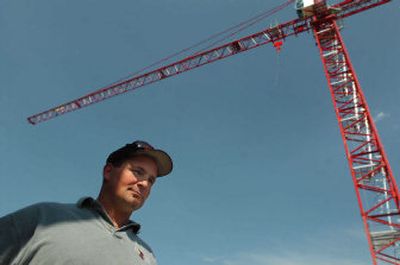Cranes in high demand

Perched 120 feet above downtown Coeur d’Alene, Scott Beeler’s job affords him great views of the lake, the mountains … and his brother.
Beeler, 38, operates a tower crane that’s helping build the Parkside, a 20-story retail-office-condo at Seventh Street and Sherman Avenue. From the control cubicle, he can keep an eye on his older brother Mike, operating another tower crane two miles away at The Terraces, a lakeside condo development.
Soon, the Beeler brothers will have other operators to watch. At least two more tower cranes are coming to North Idaho’s skyline.
If cranes, as some say, are a sign of progress, Spokane and Coeur d’Alene are booming. From the West Plains to Lake Coeur d’Alene, about half a dozen large cranes are scattered among construction sites, including the new air traffic control tower at Spokane International Airport, the 22-story Davenport Tower and Residences, and a variety of other projects.
“Spokane’s never had more than three tower cranes at once. It’s all the high-rise projects, more than we’ve had in the past,” said Terry Goebel, co-owner of R.B. Goebel General Contractor Inc., which is the contractor for the Parkside project and has a second tower crane building condos in Spokane.
Soon, even more cranes will be silhouetted against the horizon.
Coast Crane Co. recently shipped a 115-foot tower crane to Coeur d’Alene, where Walker Construction Inc. will use it to build five-story condos along the Spokane River. Coast Crane is also scrambling to get a smaller tower crane for a Boise firm building a nearby Hampton Inn & Suites.
“I’m busy because everyone and his dog is building,” said Gary Neal, Coast Crane’s senior manager in Spokane and Pasco.
The Portland-based firm is one of the largest tower crane suppliers on the West Coast, with nearly 100 in use from San Diego to Anchorage. Ordering one is a “take a number” proposition these days. Contractors can wait six to eight months for a large tower crane.
Part of the lengthy wait comes from a strong construction market worldwide, which has backlogged crane orders at the factories, said Mike Heacock, manager of Coast Crane’s tower crane division. In China, so many construction cranes fill the Shanghai skyline that they’ve been jokingly referred to as “China’s national bird.”
“Internationally, there’s a huge demand for the large cranes,” Heacock said. “Usually, the Asian markets are hot, or Europe is hot, or the U.S. is hot. It’s unusual to have everyone busy at the same time.”
In addition, tower cranes – traditionally known for getting skyscrapers off the ground – are becoming popular for small and mid-size projects, he said.
Tower cranes are the draft horses of construction sites, lugging heavy loads across long distances. Anchored in one spot, the cranes are made up of a vertical “mast” and a horizontal “jib” or “boom.” The jibs have tremendous reach.
At the Parkside project in Coeur d’Alene, the crane has a 200-foot radius. Beeler, the operator, is lowering cement and rebar into the pit that will become the tower’s underground parking garage. Eventually, he’ll whisk a 25,000-pound track hoe out of the pit and start lifting the forms that will support the Parkside’s 20 stories. With two decades of experience, Beeler can place material within a foot of where he wants it.
The crane he operates is a Potain, a French-made brand. R.B. Goebel General Contractor ordered it from Coast Crane nearly a year before the Parkside’s construction began.
It can be risky to order expensive equipment that far in advance. But in the competitive market, Goebel said he wanted to lock in the crane.
The brand-new Potain arrived by freighter in Portland and was shipped in 13 truckloads to Coeur d’Alene. It weighs 260,000 pounds and is anchored by 150 cubic yards of concrete.
The crane’s 120-foot height is impressive now, but it will extend another 84 feet by February to haul forms and mechanical equipment to the skyscraper’s upper floors.
Goebel is paying about $15,000 a month to rent the crane. Tallying the total costs for operation, he figures that the crane costs him about $250 an hour to run.
But owning one is a “crapshoot,” in Goebel’s opinion. The firm owns a smaller tower crane that’s being used to build the Upper Falls condo project in Spokane. The smaller crane has been in use 14 times since 1978, and storage is expensive.
Once a tower crane is in place, however, they generally pay for themselves, contractors said.
“They’re one of the best ways to get material moving quickly,” said Justin Paine, senior project manager for Walker Construction.
Reserving a crane was one of the first phone calls Paine made last year after his firm signed a contract to build two, five-story condo buildings at Bellerive, a development on the Spokane River in Coeur d’Alene.
A crane was secured but lost when Bellerive’s construction schedule changed. Paine was on a waiting list for another crane in October or November – “and we felt very happy to get that,” he said.
In a lucky break – “miraculous” is Paine’s exact word – another crane was freed up through a cancellation. It arrived from Seattle last week.
Over the next three weeks, the crane will grow to 115 feet in height. It will spend nearly a year on the construction site, moving materials weighing up to 10,000 pounds.
“You can’t do that with manual labor,” Paine said.